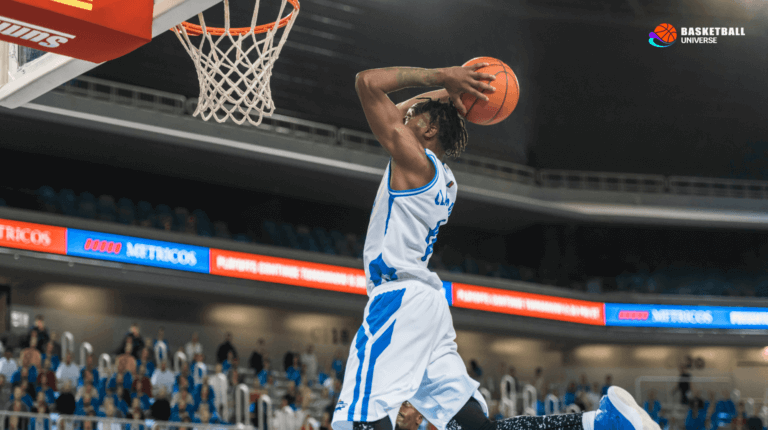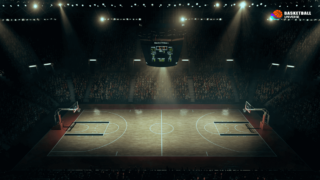
How Much Do a Basketball Weigh?
Written by: Basketball Universe
Last updated:

Have you ever paused mid-dribble to ponder, “How much does a basketball weigh?” Well, you’re in luck! In this blog post, we’re diving deep into the world of basketballs, exploring various official sizes, weights, and the importance of these features to the game. Whether you’re an avid basketball enthusiast or a curious newcomer, it’s time to discover the gravity of the game, both figuratively and literally. So, let’s bounce right into it, and unravel the mystery behind the weight of a basketball!
How Much Does a Basketball Weigh?
A basketball’s weight varies depending on its size and type. Typically, a standard official NBA basketball (Size 7) weighs around 22 ounces (623 grams). For women and youth leagues (Size 6), the weight is approximately 20 ounces (567 grams). Size 5 basketballs, designed for children aged 9-11, usually weigh around 17 ounces (482 grams). And for younger children, a Size 3 basketball weighs about 11 ounces (312 grams).
Factors That Determine Basketball Weight
The weight of a basketball is largely determined by the materials used in its construction, its size, and the league regulations that govern its specifications. Let’s explore these factors in more detail to understand the variations in basketball weight.
Material and Construction
In general, basketballs are made from durable materials, such as rubber, leather, or composite leather, depending on the intended use and level of play. Rubber basketballs are the least expensive and are often used for outdoor play. They tend to be heavier due to the denser material, providing better grip and durability on rough surfaces. Leather and composite leather basketballs are lighter in weight, offering improved ball control and feel. These are typically used for indoor play and are the preferred choice for professional and collegiate leagues.
Size Metrics
Basketballs come in several sizes, each designed to accommodate the different age groups and levels of play. The size of a basketball directly impacts its weight. The following are the most common basketball sizes and their respective weights:
- Size 7: Men’s official basketball, 29.5 inches in circumference and approximately 22 ounces (623 grams) in weight
- Size 6: Women’s and youth (12-14 years old) official basketball, 28.5 inches in circumference and around 20 ounces (567 grams) in weight
- Size 5: Youth (9-11 years old) official basketball, 27.5 inches in circumference and roughly 17 ounces (482 grams) in weight
- Size 3: Mini basketball for children under 8 years old, 22 inches in circumference and about 11 ounces (312 grams) in weight
League Regulations
Professional, collegiate, and youth basketball leagues worldwide have specific guidelines regarding the size and weight of the basketball. These guidelines ensure consistency in gameplay and adherence to the sport’s established rules. The most notable basketball organizations and their weight specifications are:
- International Basketball Federation (FIBA): Size 7 with a slightly lighter weight of 21.2 ounces (600 grams) and a tolerance of +/- 0.81 ounces (23 grams)
- National Basketball Association (NBA): Size 7 with a weight of 22 ounces (623 grams) and a tolerance of +/- 0.81 ounces (23 grams)
- Women’s National Basketball Association (WNBA): Size 6 with a weight of 20 ounces (567 grams) and a tolerance of +/- 0.81 ounces (23 grams)
- National Collegiate Athletic Association (NCAA): Size 7 for men’s basketball and Size 6 for women’s basketball, each with weight tolerances similar to the NBA and FIBA
The Importance of Basketball Weight
Understanding the significance of basketball weight is essential for both players and coaches, as it can directly impact a player’s performance, shooting technique, and overall gameplay.
Ball Control
The weight of a basketball can influence a player’s ability to control and handle the ball. Heavier basketballs may be more difficult to handle, dribble, and shoot; thus, it is important for players to use a ball that corresponds to their skill level and physical strength. Practicing with an appropriate weight will help players develop their ball control and handling skills effectively.
Shooting Consistency
A basketball’s weight can also affect a player’s shooting consistency. A heavier basketball may require more effort to shoot, causing strain on the arm and wrist and potentially hindering accurate shots. On the other hand, a lighter basketball may be too easy to shoot, leading to overshooting the basket. To achieve consistent shooting, it’s essential to practice with an official basketball for the player’s age group and league.
Injury Prevention
Using a basketball with an appropriate weight can also prevent injuries, especially among younger players. Heavier basketballs might strain young players’ wrists, arms, and shoulders, causing long-term issues in form and performance. In addition, a lighter ball may not provide the necessary resistance for players to develop proper shooting and passing techniques.
How to Choose the Right Basketball Weight
Selecting the appropriate basketball weight involves considering factors such as age, skill level, and intended gameplay. Let’s discuss how to choose the right basketball weight for your needs.
Player Age and Skill Level
When choosing a basketball, it’s crucial to consider the player’s age and skill level. Selecting a basketball that aligns with the specifications of their respective age group ensures proper weight for their physical strength and gameplay abilities:
- Size 7: Suitable for men aged 15 and older, offering the standard 22-ounce (623-gram) weight for professional gameplay
- Size 6: Designed for women aged 15 and older as well as for youth aged 12-14, featuring a lighter 20-ounce (567-gram) weight for better control
- Size 5: Ideal for children aged 9-11, with a 17-ounce (482-gram) weight to accommodate their developing skills and strength
- Size 3: Perfect for children under 8 years old, providing an 11-ounce (312-gram) weight for their smaller hands and beginner skill level
Indoor vs. Outdoor Play
Contact with different playing surfaces is a vital factor to consider when selecting a basketball. Rubber basketballs, being denser and heavier, are more suitable for outdoor courts since they offer better grip and durability. Leather and composite leather basketballs are generally preferred for indoor courts due to their lighter weight and improved feel. Make sure to choose a basketball that aligns with your gameplay preferences and location.
League Requirements
If you’re participating in organized basketball competitions, considering the league requirements is essential when selecting a basketball. Adhering to the specified ball size and weight ensures consistent gameplay and proper technique development. Please consult your league’s specific rules and guidelines to choose the appropriate basketball.
Tips for Mastering Basketball Weight in Training
Adjusting to and mastering the weight of a basketball can significantly enhance your performance on the court. Here are some helpful tips to improve your gameplay:
Strength Training
Strength training, particularly in arm, wrist, and shoulder muscles, is crucial for effectively handling and controlling a basketball of any weight. Incorporating exercises that target these muscle groups will not only improve your muscle strength but will also help you build the necessary shooting and dribbling techniques for optimal gameplay.
Practice with Different Weighted Balls
While practicing with an official basketball is crucial for developing proper gameplay skills, occasionally using basketballs of different weights can prove beneficial. Training with a slightly heavier ball might improve your strength and shooting technique. Similarly, practicing with a lighter basketball can help enhance your precision, touch, and finesse. Remember not to overdo it, though, as there is a risk of developing incorrect form and habits.
Focus on Technique
When training with different weighted basketballs, always focus on maintaining proper form and technique. This includes shooting, dribbling, and passing. Pay attention to your body mechanics and make necessary adjustments to suit the weight of the ball without compromising your overall technique. This practice ensures that you can adapt to various basketball weights while maintaining consistency in your gameplay.
Basketball Accessories for Weight Adaptation
Several basketball training accessories can aid in adjusting to different basketball weights and enhancing your overall gameplay. Some of these accessories include:
Weighted Basketball Training Gloves
These gloves add weight to the hands, increasing resistance and muscle activation during dribbling, shooting, and passing. Using weighted gloves during practice can help improve strength, control, and consistency when handling basketballs of varying weights.
Weighted Basketball Sleeves
Specially designed sleeves can be worn on the arms to provide additional weight and resistance, leading to improved muscle strength and shooting technique. By practicing with weighted sleeves, you can enhance your gameplay skills and adapt to the official basketball weight more effectively.
Basketball Trainer Ball
A basketball trainer ball is a specially designed basketball with an additional weight to help players simulate increased resistance during practice. By training with a trainer ball, you can develop better ball control, precision, and strength when handling basketballs of different weights.
Understanding basketball weight and its impact on gameplay is essential for players looking to improve their performance and skill level. By selecting the right ball weight for your age and league, mastering proper technique, and utilizing training accessories, you can enhance your basketball abilities and conquer the court!
Maintaining Basketball Weight and Pressure
To ensure optimal performance and playability, it’s essential to maintain your basketball’s weight and pressure regularly. Proper maintenance ensures consistent gameplay and a longer lifespan for your basketball.
Checking Basketball Pressure
A basketball’s pressure is measured in pounds per square inch (PSI). The ideal pressure depends on the ball’s specifications and the league’s standards. A general guideline for basketball pressure is as follows:
- NBA: 7.5 to 8.5 PSI
- FIBA: 7.3 to 8.1 PSI
- WNBA: 7.5 to 8.5 PSI
- NCAA: Men’s and women’s basketballs should have a pressure between 7.5 to 8.5 PSI
Regularly checking your basketball’s pressure is crucial to maintain accurate weight and ensure consistent gameplay. Use a pressure gauge to measure the PSI and adjust it according to your league’s requirements or personal preference. Check the pressure at least once a month.
Proper Storage and Care
Proper storage and care are important factors in maintaining your basketball’s weight and performance. Follow these tips to keep your basketball in excellent condition:
- Store your basketball in a dry, cool place away from direct sunlight to prevent material deterioration and color fading.
- Avoid exposing your basketball to harsh weather conditions, such as extreme cold or heat, to preserve its weight and texture.
- Clean your basketball regularly with a damp cloth to remove dirt and debris that may affect its handling and weight.
- Rotate your basketball during use to ensure even wear and consistent weight distribution.
- If your basketball becomes waterlogged, let it dry in a well-ventilated area to restore its standard weight and performance.
The Impact of Altitude on Basketball Weight and Performance
Altitude can influence the weight and performance of a basketball due to the change in air pressure at higher elevations. Here’s how altitude affects basketball weight and gameplay:
Pressure Regulation
The internal pressure of a basketball can be affected by the external air pressure at varying altitudes. Generally, the higher the altitude, the lower the ambient air pressure, which can cause the basketball to become over-inflated. It’s essential to adjust the pressure of your basketball accordingly to maintain consistent weight and handling, especially when playing at higher altitudes.
Shooting and Ball Trajectory
Higher altitudes with thinner air can affect the trajectory and flight of the basketball when shooting. Players might need to adjust their shooting technique to account for the change in air resistance and ball dynamics at higher altitudes. Practicing at the specific altitude you’ll be playing in can help you adapt and optimize your shooting technique.
Aerobic Fitness and Fatigue
Playing basketball at higher altitudes might impact players’ aerobic fitness and fatigue levels due to the reduced oxygen levels in the air. This factor can indirectly affect a player’s ability to handle and control the basketball. To mitigate these issues, athletes can gradually acclimate to the altitude by participating in pre-game practices or undergoing specialized high-altitude training.
Understanding the effects of altitude on basketball weight and performance can help you adapt and maintain consistent gameplay, regardless of where you play. Whether you’re competing in the mountains, the city, or by the sea, knowing the nuances of basketball weight, pressure, and altitude ensures you’re always at the top of your game!
FAQ: Frequently Asked Questions Related To Basketball Weight
Do you still have questions surrounding basketball weight, its impact on gameplay, and other related aspects? Our frequently asked questions (FAQ) section covers a variety of common inquiries to help clarify and expand your knowledge on the subject.
1. How much does an official NBA basketball weigh?
An official NBA basketball (Size 7) weighs approximately 22 ounces (623 grams).
2. Does the weight of a basketball vary for different leagues or age groups?
Yes, basketball weight varies depending on the league and age group. Most men’s leagues use Size 7 basketballs, weighing about 22 ounces (623 grams). Women and youth leagues typically use Size 6 basketballs, weighing around 20 ounces (567 grams). For younger children, lighter basketballs like Size 5 or Size 3 are used, with weights of 17 ounces (482 grams) and 11 ounces (312 grams), respectively.
3. Do indoor and outdoor basketballs have different weights?
Indoor and outdoor basketballs may have slightly different weights due to variations in the materials used. Rubber basketballs, typically used for outdoor play, tend to be heavier due to the denser material. Leather and composite leather basketballs, usually used indoors, are lighter in weight and offer better control.
4. How does basketball weight affect performance on the court?
Basketball weight can impact a player’s ball control, shooting consistency, and injury risk. An appropriate basketball weight allows players to develop proper form and technique, ensuring optimal performance during gameplay.
5. Can I use a lighter basketball if I find the official size too heavy?
It’s essential to practice with an official basketball for your age group and skill level to develop proper shooting, dribbling, and passing techniques. However, occasionally using a slightly lighter basketball during practice may help improve your precision, touch, and finesse. Just be mindful not to overdo it, as you might develop bad habits and incorrect form.
6. How do I know if my basketball is properly inflated?
Use a pressure gauge to measure your basketball’s pressure in pounds per square inch (PSI). The ideal PSI varies depending on league requirements; however, a general guideline is 7.5 to 8.5 PSI for NBA, WNBA, and NCAA basketballs, and 7.3 to 8.1 PSI for FIBA basketballs. Adjust the pressure accordingly to maintain accurate weight and performance.
7. How often should I check the pressure and weight of my basketball?
It’s recommended to check your basketball’s pressure at least once a month. By maintaining proper pressure, you can ensure consistent weight and performance during gameplay.
8. Can the weight of a basketball affect a player’s shooting range?
Yes, the weight of a basketball can affect a player’s shooting range. A heavier basketball may require more effort to shoot, causing strain on the arm and wrist, whereas a lighter basketball may be more difficult to control and result in overshooting. Practicing with an appropriate-weight basketball helps players develop the strength and technique required for accurate shooting and optimal range.
9. How can I improve my ball control with different weighted basketballs?
Strength training, particularly for your arm, wrist, and shoulder muscles, is essential for improving your ability to control and handle different weighted basketballs. Additionally, incorporating practice sessions with different weights can help build strength and improve your technique for optimal ball control.
10. Are there any training accessories to help me adapt to different basketball weights?
Yes, there are several training accessories to assist with adapting to different basketball weights, including weighted basketball training gloves, weighted basketball sleeves, and basketball trainer balls. Using these accessories in your practice sessions can improve your strength, precision, and ball control.
11. Can altitude affect basketball weight and performance?
Yes, altitude can impact basketball weight and performance. At higher elevations, the thinner air can cause basketballs to become over-inflated, affecting their internal pressure, weight, and handling. Adjustments to shooting technique and ball pressure may be necessary when playing at higher altitudes.
12. How can I maintain the weight and performance of my basketball?
To maintain your basketball’s weight and performance, regularly check its pressure, store it in a cool, dry place, clean it with a damp cloth, rotate it during use, and avoid exposure to harsh weather conditions.
13. How do I choose the right basketball weight for my playing needs?
Select the appropriate basketball weight by considering your age, skill level, gameplay location (indoor or outdoor), and the requirements of the league you participate in. This will ensure proper weight for your physical strength and gameplay abilities, ultimately allowing for effective skill development and performance on the court.
Featured Posts
- No pillar pages found.





